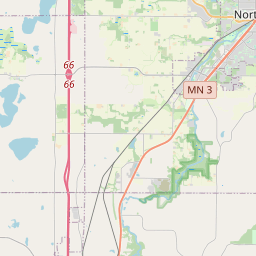Sesquicentennial Legacy Plaza
Historical marker location:
Northfield, Minnesota
( Marker can be reached from South Water Street north of Fifth Street West (Minnesota Highway 19), on the left when traveling north.)
Marker installed: 2008







© OpenStreetMap contributors
2008
Loading...
Searching for other points of interest within 3 miles of this location.The Mall of America, located in Bloomington, Minnesota, is the largest mall in the United States, with over 5.6 million square feet of retail space.
About Rice County
Rice County Timeline
Rice County, located in southern Minnesota, has a rich history dating back thousands of years. The first inhabitants of the region were Native American tribes, including the Dakota Sioux and Winnebago people. These tribes relied on the natural resources of the area, particularly the water sources and fertile soil for agricultural purposes.
In the mid-19th century, European settlers began to establish themselves in Rice County. The county was officially created in 1853 and named after Henry Mower Rice, a prominent politician and pioneer in Minnesota. The town of Faribault was chosen as the county seat, which quickly became a prosperous and influential town in the region.
The region's economy in the early years of settlement was primarily agriculture-based, with farming being the primary occupation of its residents. Rice County also became a key location in the development of flour milling and grain production in Minnesota. Numerous mills were established along the Straight River and Cannon River, which provided power for these industries.
Over the years, Rice County experienced growth and development in various sectors. The establishment of educational institutions, such as Carleton College and Shattuck-St. Mary's School, brought culture and intellectual life to the area. In more recent times, the county has seen further diversification with the expansion of healthcare, retail, and manufacturing industries.
Today, Rice County is a vibrant community that honors its history while embracing growth and progress. Visitors and residents alike enjoy its natural beauty, historic sites, and the rich heritage that has shaped the county into what it is today.
In the mid-19th century, European settlers began to establish themselves in Rice County. The county was officially created in 1853 and named after Henry Mower Rice, a prominent politician and pioneer in Minnesota. The town of Faribault was chosen as the county seat, which quickly became a prosperous and influential town in the region.
The region's economy in the early years of settlement was primarily agriculture-based, with farming being the primary occupation of its residents. Rice County also became a key location in the development of flour milling and grain production in Minnesota. Numerous mills were established along the Straight River and Cannon River, which provided power for these industries.
Over the years, Rice County experienced growth and development in various sectors. The establishment of educational institutions, such as Carleton College and Shattuck-St. Mary's School, brought culture and intellectual life to the area. In more recent times, the county has seen further diversification with the expansion of healthcare, retail, and manufacturing industries.
Today, Rice County is a vibrant community that honors its history while embracing growth and progress. Visitors and residents alike enjoy its natural beauty, historic sites, and the rich heritage that has shaped the county into what it is today.
Rice County Timeline
This timeline provides a glimpse into the major events and milestones that have shaped the history of Rice County, Minnesota.
- 1851 - Rice County is established as one of the original nine counties of Minnesota.
- 1853 - The town of Faribault is founded, becoming the first county seat.
- 1865 - The Northfield Bank is established, leading to the growth of the city of Northfield.
- 1871 - Rice County experiences a devastating grasshopper plague, causing significant crop damage.
- 1877 - The construction of the Stillwater and Winona Railroad begins, connecting Rice County to other parts of the state.
- 1895 - The Rice County Courthouse is built, becoming a symbol of civic pride and architectural beauty.
- 1923 - Carleton College, a renowned liberal arts institution, moves to Northfield.
- 1935 - The creation of the Minnesota State Academy for the Deaf in Faribault promotes accessibility to education for the deaf community.
- 1969 - The community experiences severe flooding, causing significant damage to homes and infrastructure.
- 1999 - The Northfield Historical Society opens the Northfield Historical Society Museum, preserving the rich history of the county.
- 2002 - The Faribault Woolen Mill is reopened, reinvigorating the local textile industry.